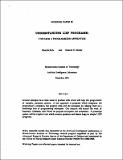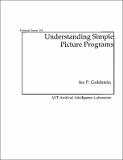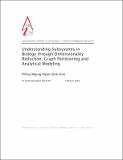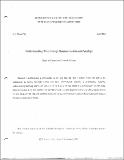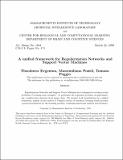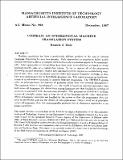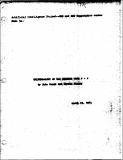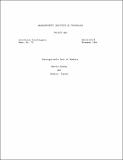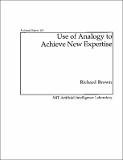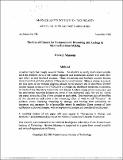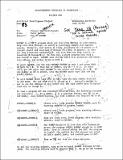Browsing Artificial Intelligence Lab Publications by Title
Now showing items 1721-1740 of 1835
-
Understanding LISP Programs: Towards a Programmer's Apprentice
(MIT Artificial Intelligence Laboratory, 1974-12)Several attempts have been made to produce tools which will help the programmer of complex computer systems. A new approach is proposed which integrates the programmer's intentions, the program code, and the comments, by ... -
Understanding Scenes With Shadows
(MIT Artificial Intelligence Laboratory, 1971-11)The basic problem of this research is to find methods which will enable a program to construct a three dimensional interpretation from the line drawing of a scene, where the scene may have shadows and various degeneracies. ... -
Understanding Simple Picture Programs
(1974-04-01)What are the characteristics of the process by which an intent is transformed into a plan and then a program? How is a program debugged? This paper analyzes these questions in the context of understanding simple turtle ... -
Understanding Subsystems in Biology through Dimensionality Reduction, Graph Partitioning and Analytical Modeling
(2003-02-05)Biological systems exhibit rich and complex behavior through the orchestrated interplay of a large array of components. It is hypothesized that separable subsystems with some degree of functional autonomy exist; deciphering ... -
Understanding Text through Summarization and Analogy
(1983-04-01)Understanding a text exactly in the way that the Text Producer meant the text to be understood is highly unlikely unless the text interpretation process is constrained. Specific understanding-directing criteria are ... -
Understanding Understanding Mathematics
(1978-08-01)In this paper we look at some of the ingredients and processes involved in the understanding of mathematics. We analyze elements of mathematical knowledge, organize them in a coherent way and take note of certain ... -
A Unified Framework for Regularization Networks and Support Vector Machines
(1999-03-01)Regularization Networks and Support Vector Machines are techniques for solving certain problems of learning from examples -- in particular the regression problem of approximating a multivariate function from sparse ... -
A Unified Statistical and Information Theoretic Framework for Multi-modal Image Registration
(2004-04-28)We formulate and interpret several multi-modal registration methods in the context of a unified statistical and information theoretic framework. A unified interpretation clarifies the implicit assumptions of each method ... -
UNITRAN: A Principle-Based Approach to Machine Translation
(1987-12-01)Machine translation has been a particularly difficult problem in the area of Natural Language Processing for over two decades. Early approaches to translation failed since interaction effects of complex phenomena in ... -
UNITRAN: An Interlingual Machine Translation System
(1987-12-01)This report describes the UNITRAN (UNIversal TRANslator) system, an implementation of a principle-based approach to natural language translation. The system is "interlingual", i.e., the model is based on universal ... -
Universality of TAG Systems with P-2
(1963-04-01)In the following sections we show, by a simple direct construction, that computations done by Turing machines can be duplicated by a very simple symbol manipulation process. The process is described by a simple form of ... -
Unrecognizable Sets of Numbers
(1964-11-01)When is a set A of positive integers, represented as binary numbers, "regular" in the sense that it is a set of sequences that can be recognized by a finite-state machine? Let pie A(n) be the number of members of A less ... -
The Unsupervised Acquisition of a Lexicon from Continuous Speech
(1996-01-18)We present an unsupervised learning algorithm that acquires a natural-language lexicon from raw speech. The algorithm is based on the optimal encoding of symbol sequences in an MDL framework, and uses a hierarchical ... -
Use of Analogy to Achieve New Expertise
(1977-04-01)We will take the view that the end result of problem solving in some world should be increased expertness. In the context of computers, increasing expertness means writing programs. This thesis is about a process, ... -
The Use of Censors for Nonmonotonic Reasoning and Analogy in Medical Desicion-Making
(1985-11-01)A patient rarely has a single, isolated disease. The situation is usually much more complex since the different parts of the human organism and metabolism interact with each other and follow several feedback patterns. ... -
The Use of Dependency Relationships in the Control of Reasoning
(MIT Artificial Intelligence Laboratory, 1976-11)Several recent problem-solving programs have indicated improved methods for controlling program actions. Some of these methods operate by analyzing the time-independent antecedent-consequent dependency relationships between ... -
The Use of Equality in Deduction and Knowledge Representation
(1980-01-01)This report describes a system which maintains canonical expressions for designators under a set of equalities. Substitution is used to maintain all knowledge in terms of these canonical expressions. A partial order ... -
The Use of Grouping in Visual Object Recognition.
(1988-01-01)The report describes a recognition system called GROPER, which performs grouping by using distance and relative orientation constraints that estimate the likelihood of different edges in an image coming from the same ... -
Use of MACDMP
(1965-07-01)MACIMP is a PDP-6 program which can load from DECtape to core memory, dump core onto DECtape, or verify a previously dumped filel against memory. Normally, just before it loads, it clears all of memory to 0 (except itself ... -
The Use of Parallelism to Implement a Heuristic Search
(1981-03-01)The role of parallel processing in heuristic search is examined by means of an example (cryptarithmetic addition). A problem solver is constructed that combines the metaphors of constraint propagation and hypothesize-and-test. ...
